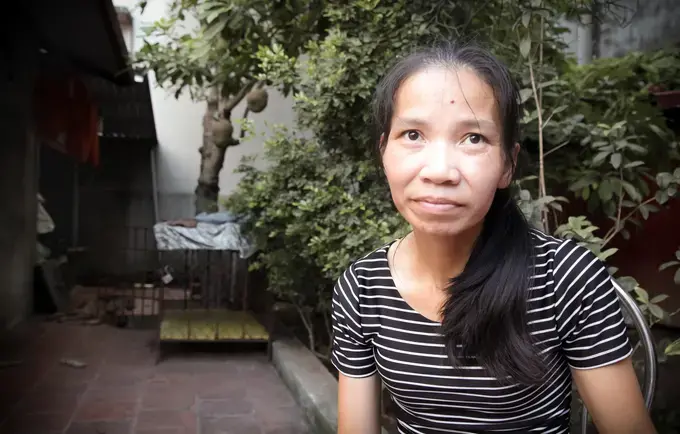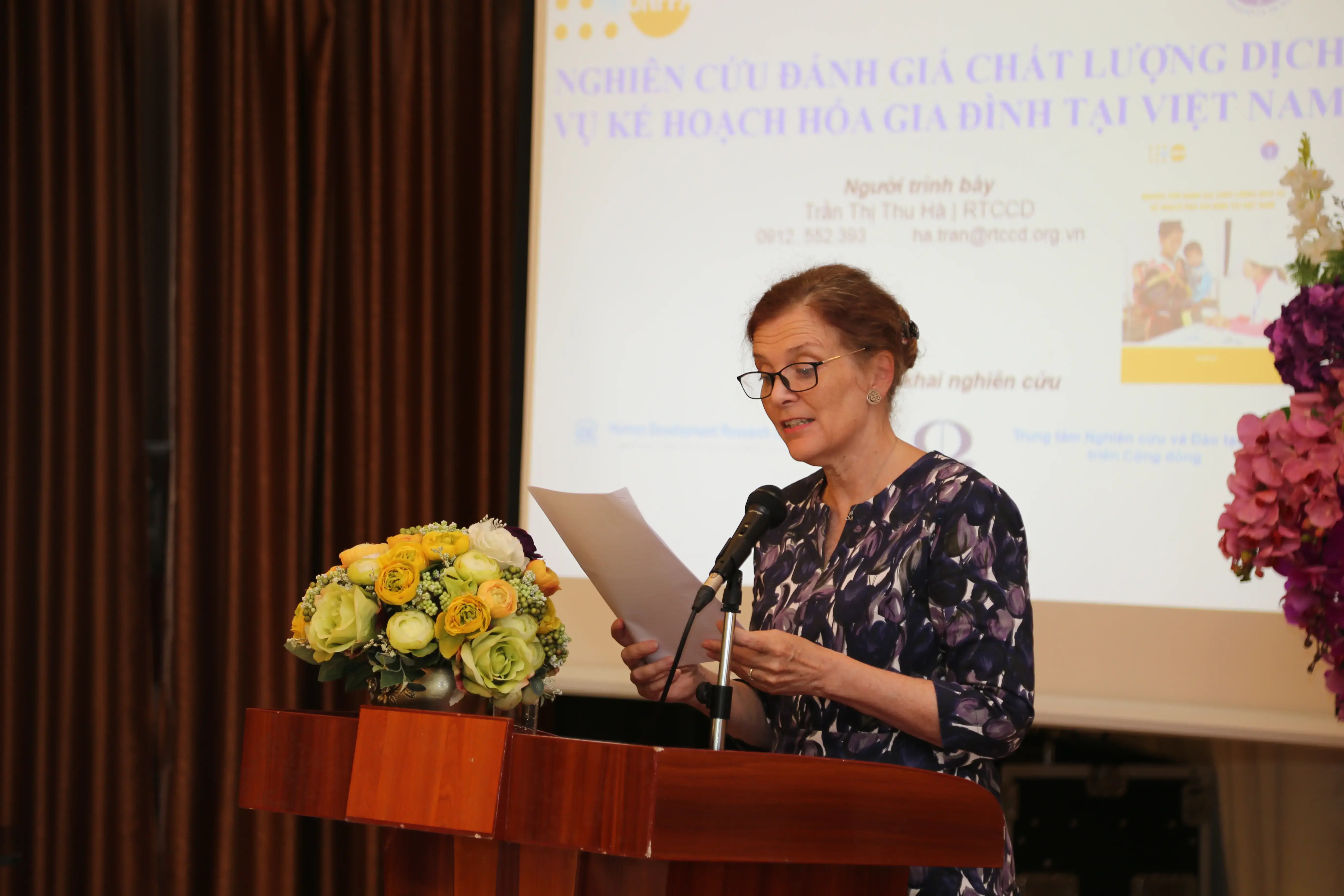Mr. Nguyen Viet Tien, Vice Minister of Health;
Representatives from provinces, Embassies, International Organizations, Civil Society Organisations, fellow UN colleagues and media;
Ladies and gentlemen,
A very good morning to all of you;
It is a pleasure to be here today, for the launching of the first ever National Midwifery Report and the Report on “Exploring barriers to accessing Maternal and Family Planning services in Ethnic Minority communities”.
On behalf of the UNFPA in Viet Nam, I would like to sincerely thank the Ministry of Health for co-organizing this ceremony to launch these important reports. I would also like to especially thank the Honorable Vice-Minister, Mr. Nguyen Viet Tien, for his inspiring opening speech.
Today, we are launching two reports: one on national midwifery and one on barriers to accessing maternal and family planning services in ethnic minority communities. These two reports investigate various aspects of health care system and community reproductive health perspectives and behaviors, yet their findings are convergent and complement each other, therefore enabling the development of clear recommendations for policy makers, programme managers, health professionals, researchers and donors in designing and implementing effective reproductive health programmes. So these programmes fully contribute to achievement of the objectives of the International Conference on Population and Development and the Sustainable Development Goals in Viet Nam.
These two reports were developed by the Ministry of Health, with technical and financial support from UNFPA. We would like to thank Dr. Sarah Bales and Prof. Sue Kildea for their dedication and enthusiasm to complete the National Midwifery Report. We would also like to thank the research team of the University of Toronto and the Mekong Development Research Institute for implementing the study on "Exploring barriers to accessing maternal health and family planning services in ethnic minority communities in Viet Nam". And of course, we would particularly like to thank more than 4,600 ethnic minority women and health providers and managers at all levels who participated in these two important studies.
Distinguished guests,
Next month, on May 5th, the world will celebrate the heroic and life-saving work of midwives on the International Day of Midwives. Thanks to midwives, millions of women each year are able to exercise their right to sexual and reproductive health services, including voluntary family planning. These services help ensure wanted, healthy pregnancies and safe births.
Yet, far too many women lack access to these services. As a result, at global level, each year more than 300,000 women die during pregnancy and childbirth, some 3 million babies do not survive the first month of life, and another two and a half million babies are stillborn. Most of them could have been saved by the care of well-trained midwives within the framework of strong health systems.
Distinguished guests,
Viet Nam has made substantial progress in strengthening safe motherhood and newborn health services. As indicated in the National Midwifery Report, , the national competencies for midwives, developed and introduced in line with the International Confederation of Midwives' recommendations, and the National Programme of Action (NPA) for strengthening Nursing and Midwifery services 2012-2020 approved over the past years showed the strong commitment and efforts of the Government in strengthening the national health workforce and achieving the Sustainable Development Goals by 2030. These documents also provided a framework for improving the status of midwives working at all levels, particularly at the grassroots level and in midwifery education.
However, findings from the study on maternal and FP services in ethnic minority region indicate big geographical differences between the national average and mountainous areas. For instance, the proportion of births attended by skilled health personnel differed by 45 percentage points between ethnic minority participants and national estimates (49% vs. 94%).
The modern contraceptive prevalence rate among ethnic minorities was 57% overall, similar to the national average. However, there was wide variation between provinces and ethnic minority communities, with the rate being 75% in Kon Tum Province compared to 45% in Gia Lai Province; and 41-42% for Ba Na and Gia Rai groups to over 70% for Tay and Sedang ethnic groups.
Data also reveals a significant shortage of skilled birth attendants in hard-to-reach regions and a significant difference in the competency of workers who are working in the lowlands compared to the highlands. 94% of practicing midwives are trained at secondary level and only 0.8% has bachelor qualifications. If we follow Circular 26 that only midwives at level 4 can provide FP services, approximately 33,000 secondary and elementary midwives and obstetric-paediatric assistant doctors need to be upgraded to 3-year qualifications by 2025. There is a major concern about the feasibility of implementing the Circular 26 roadmap due to the still limited capacity of current midwifery training institutions.
Ladies and gentlemen,
Before giving the floor to my colleagues to present key findings of these reports, I would like to reiterate a few key messages and calls for action that are highlighted in the reports:
First, more efforts are needed in improving quality of maternal health services focusing on six strategic areas: clinical guidelines, standards of care, effective interventions, measures of quality of care, relevant research, and capacity building. Community and service users are critical in identifying their needs and preferences and in managing their own health.
Second, Circular 26’s scopes of responsibilities for Level IV midwives, and the timeline and alternative options for upgrade training needs to be revised urgently;
Third, the midwife-led maternity care service model should be implemented as human resources and other conditions permit and enforcement measures must be taken to enforce compliance with national reproductive health service guidelines and reduce unnecessary C-section and episiotomy and other over-servicing.
Fourth, monitoring and evaluation by the National Assembly and MoH should be strengthened with the active participation of ethnic minority representatives to track accountabilities and responsibilities of local authorities on the performance of the local health care network in disadvantaged regions.
Last but not the least, investing in human resources for health, especially for midwives, is one of the soundest investments a country can make. It is of utmost importance to reinforce the status of midwives. Midwives also need to be provided with sufficient technical guidance/protocols, medical instruments, supplies and drugs, backed up by mobile technology and with the support of other health staff for technical support in case of emergencies, including a timely and effective referral system. When midwives are properly trained, empowered and supported, they can contribute significantly to saving the lives of mothers and newborns, as well as improving the nation’s economic and social productivity. Having midwives at the bedside of every pregnant woman is a highly cost-effective public health strategy. Over time there has been recognition of mobile communication technology as a way of assisting our midwives, including our ethnic minority midwives, working in remote and hard-to-reach areas of the country.
Distinguished guests,
Preventing maternal and newborn deaths and disabilities and empowering women to make informed, healthy choices and exercise their rights is key to achieving the Sustainable Development Goals by 2030. To make this happen, we need to expand midwifery programmes, maintaining the highest global standards, and promote an enabling environment for midwives to effectively serve the needs of women and their families.
As Viet Nam continues to progress socially and economically, we must recognize that we cannot achieve sustainable development without promoting the health - and especially the reproductive health and rights - of women and girls throughout their life cycle. The UNFPA in Viet Nam is fully committed to support the Government and people of Viet Nam to ensure that universal access to health, including sexual and reproductive health, will become a reality for all. By joining forces and working together, I believe no goal is too high to reach.
On this occasion, I urge all government sectors and development partners to join UNFPA in supporting midwives so more women survive and they, their families and communities thrive.
Thank you very much for your attention and participation. I look forward to discussing these issues with you further during this workshop.




